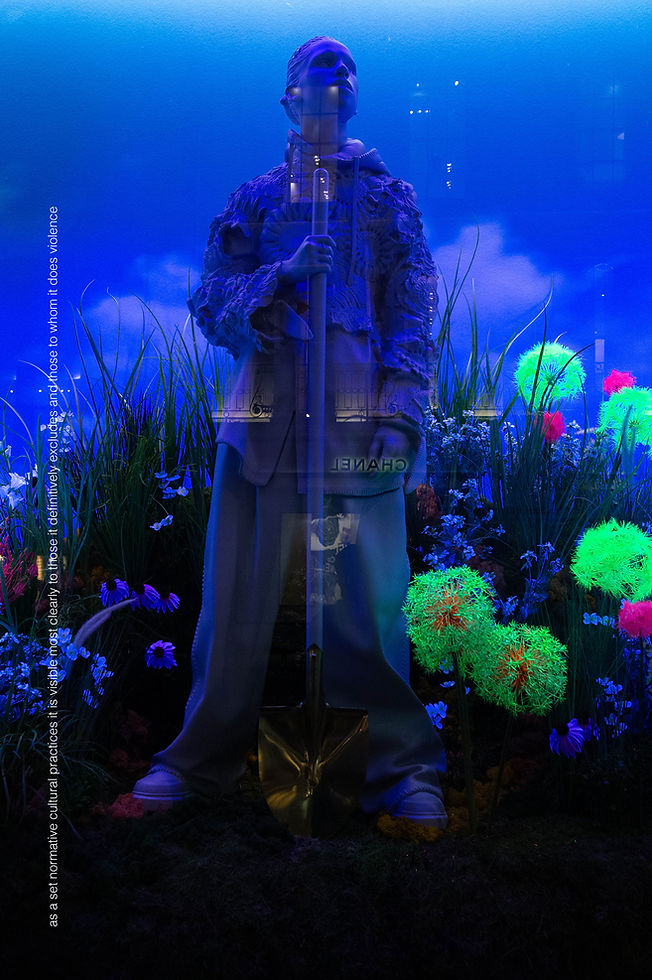Shop - Selling the Ontology of Whiteness

Photographic Lightbox - Work in Progress - minimum size 1m x 1.50m

Photographic Lightbox - Work in Progress - minimum size 1m x 1.50m

Photographic Lightbox - Work in Progress - minimum size 1m x 1.50m

Photographic Lightbox - Work in Progress - minimum size 1m x 1.50m

Photographic Lightbox - Work in Progress - minimum size 1m x 1.50m

Photographic Lightbox - Work in Progress - minimum size 1m x 1.50m

Photographic Lightbox - Work in Progress - minimum size 1m x 1.50m
In Shop... Selling the Ontology of Whiteness, Forbes started out by exploring the visual representation of fashion and handbags as desired objects. Initially he started purchasing counterfeit handbags from African migrants on the streets of Europe, for his masquerade sculptural works. He later started documenting shop windows on his travels including Venice, Rome, Naples and London, during this period a number of interesting ideas started to emerge from the images and the research for his dissertation, at the time (titled; The Metaphysics and Racial Politics of Blackness through the work of Kerry James Marshall). The idea /question that came up, was what is being sold through the shop windows, beyond the merchandise? He concluded, from what he could see and the information he was absorbing from his research, was the ontology of whiteness is being actively promoted through the shop windows and the use of the mannequins.
The mannequins are predominately white, with a small percentage being brown and a few with a black person’s facial features, but coloured white or shades of blue. Forbes’ hypothesis here is the mannequins with black facial features, are not allowed to be black/brown, thereby undermining and devaluing blackness in the capitalist system of creating desire. For Forbes there is a clear message here, that whiteness sells luxury goods, but an element of blackness carries some cachet, coolness, edgy or danger, but not enough to be the main visual representation of the shop windows.
The text layers in the work explores the extremities of racialised politics and discrimination in relation to whiteness. The abstract text creates a form of push me pull me dilemma, whereby the viewer is drawn in by the beauty of the photographic image, but part challenged by the text.
The work allows the viewer to question their own positionality in relation to this critique. The layering is used as an aesthetic tool in line with fashion advertising, more strikingly the text is a genuine link to racialised political discourse of today.
Initially designed to attract passersby and stimulate consumer interest, shop windows have evolved to encompass more complex and nuanced objectives. Consumers today, while expecting innovative concepts to capture their attention, still respond fundamentally to the shop window’s primary function of enticing them into stores. This dichotomy reflects a blend of sophistication and simplicity in consumer behaviour, analogous to Roland Barthes’ concepts of Studium and Punctum in photography.
Barthes’ framework provides a lens through which Forbes’ photographic approach can be analysed. The Studium, representing the cultural, linguistic, and political interpretation of a photograph, finds resonance in Forbes’ portrayal of shop windows as cultural artifacts laden with socio-economic significance. The Punctum, on the other hand, refers to the personal, often emotional, impact a photograph may have on an individual. Forbes integrates this aspect by juxtaposing textual elements with his images, thereby creating a nuanced interplay that enriches the viewer’s engagement.
Critical to Forbes’ narrative is the notion of visibility and representation. Through his lens, he highlights the selective visibility of racialised identities within consumerist spaces, where blackness is often subsumed or superficially represented. This critique extends beyond the mere depiction of mannequins to encompass broader societal constructs of beauty, desirability, and cultural identity within the capitalist system. By foregrounding these issues, Forbes invites viewers to critically engage with the ways in which consumer culture perpetuates and reinforces socio-cultural hierarchies.

Photographic Lightbox - Work in Progress - minimum size 1m x 1.50m




